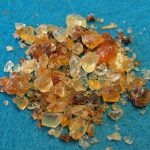Xanthin (often referred to as xanthan or xanthan gum) is a polysaccharide used as a food additive and rheology modifier. It is produced by the fermentation of glucose or sucrose by the bacterium Xanthomonas campestris.
Here are some key points about xanthan gum:
- Thickening Agent: Xanthan gum is widely used as a thickening agent in various food products. It helps increase the viscosity of liquids without altering their taste, making it ideal for sauces, dressings, and syrups.
- Stabilizer: It acts as a stabilizer in emulsions, helping to keep ingredients uniformly mixed. This is especially useful in products like salad dressings, ice creams, and gluten-free baked goods.
- Gluten-Free Baking: In gluten-free baking, xanthan gum is often used to replicate the elastic properties of gluten, providing structure and preventing the baked goods from being too crumbly.
- Suspension Agent: Xanthan gum helps suspend solid particles in liquids, making it useful in products like juices and beverages with pulp.
- Low-Calorie Content: Xanthan gum adds viscosity and stability without significantly increasing the caloric content of foods, making it a preferred additive for low-calorie and diet foods.
- Versatility in Other Industries: Beyond food, xanthan gum is also used in cosmetics, pharmaceuticals, and oil drilling industries. In cosmetics, it helps stabilize products like lotions and creams. In pharmaceuticals, it can be used as a stabilizer or to control the release of active ingredients. In oil drilling, it is used to thicken drilling fluids.
- Safety and Regulations: Xanthan gum is generally recognized as safe (GRAS) by the FDA and is approved for use in foods and other products in many countries. However, some individuals may experience digestive issues if consumed in large quantities.
- Solubility: Xanthan gum is highly soluble in both hot and cold water, which makes it convenient to use in a wide range of temperatures and recipes.
In summary, xanthan gum is a versatile and widely used food additive that enhances the texture, stability, and consistency of various products, making it a valuable ingredient in many culinary and industrial applications.
Xanthan gum is primarily used as a food additive for its thickening, stabilizing, and emulsifying properties, but it also offers some potential health benefits.
Here are a few potential health benefits:
- Blood Sugar Control: Some studies suggest that xanthan gum can help stabilize blood sugar levels by slowing the absorption of sugar into the bloodstream. This can be particularly beneficial for individuals with diabetes.
- Cholesterol Reduction: Research has indicated that xanthan gum may help lower cholesterol levels. In some studies, participants consuming xanthan gum experienced a decrease in total and LDL (bad) cholesterol levels.
- Digestive Health: Xanthan gum is a soluble fiber, which can contribute to digestive health by promoting regular bowel movements and preventing constipation. It can also act as a prebiotic, supporting the growth of beneficial gut bacteria.
- Weight Management: Because xanthan gum is a soluble fiber, it can help promote a feeling of fullness, which may aid in weight management by reducing overall calorie intake.
- Gluten-Free Diets: For individuals with celiac disease or gluten sensitivity, xanthan gum is a valuable ingredient in gluten-free baking. It helps provide the texture and elasticity that gluten would typically offer, making gluten-free products more palatable and structurally sound.
- Hydration and Moisture Retention: In products like lotions and creams, xanthan gum helps to retain moisture, which can be beneficial for skin hydration.
While these potential health benefits are promising, it’s important to note that xanthan gum should be consumed in moderation. High amounts can lead to digestive issues such as bloating and gas, especially for individuals with sensitive digestive systems.
Overall, while xanthan gum offers certain health benefits, its primary use remains as a food additive to improve the texture and stability of various products.
READ MORE: Gluten Intolerance
Sources:
https://www.news-medical.net/news/20221227/Xanthan-gum-based-fluid-thickener-can-lower-blood-glucose-levels-after-eating-study-shows.aspx
https://www.forbes.com/health/nutrition/xanthan-gum/#:~:text=This%20mechanism%20of%20action%20in,control%20group%2C%E2%80%9D%20notes%20Ayesta.
https://www.cnet.com/health/nutrition/xanthan-gum-harmless-food-additive-or-digestion-nightmare/









